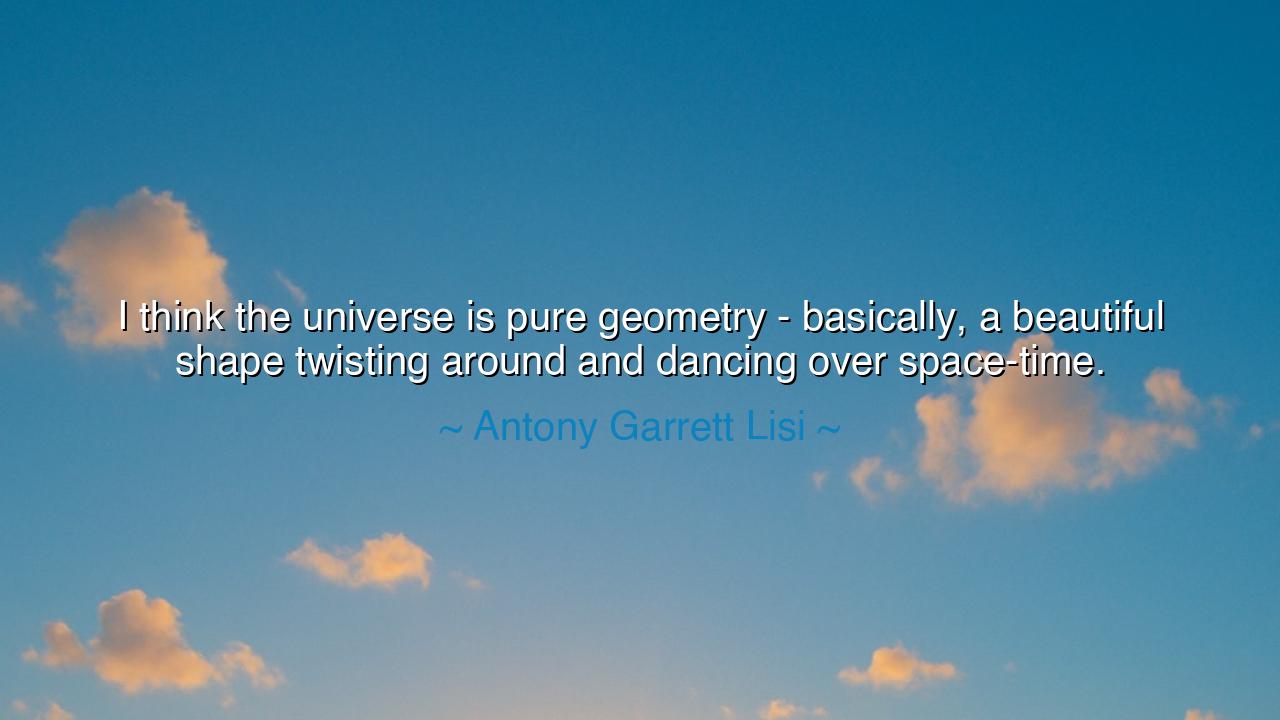
I think the universe is pure geometry - basically, a beautiful
I think the universe is pure geometry - basically, a beautiful shape twisting around and dancing over space-time.






In the endless reaches of existence, where the stars spin like the threads of fate and the galaxies swirl in their eternal dance, there is a truth that beckons to us all: the universe is not a chaotic, disordered place, but a symphony of perfect geometry. Antony Garrett Lisi, a man whose mind has wandered the edges of our understanding, spoke of this truth when he said, "I think the universe is pure geometry - basically, a beautiful shape twisting around and dancing over space-time." His words, simple yet profound, speak of a deeper harmony, a truth woven into the very fabric of the cosmos itself—a divine, elegant design that holds the universe together in its intricate dance.
To understand Lisi’s words, one must first understand that the universe is not a mere collection of stars, planets, and empty spaces. It is a living tapestry, a pattern of interconnected forces and energies. Geometry is the language in which this tapestry is written, and it is through the study of shapes, angles, and proportions that we begin to unravel the mystery of existence. Just as a skilled artist shapes a work of beauty from simple materials, so too does the universe shape itself through the forces of nature, twisting and turning in elegant forms, like a dancer moving across a cosmic stage. The dance of the stars, the paths of the planets, and the fabric of space-time itself are all part of this great geometric performance.
Consider, if you will, the ancient Greeks, who first began to recognize the beauty of geometry in the heavens. They saw the perfect shapes of the circle and the sphere reflected in the movements of the planets, and they believed that these shapes were not mere accidents, but the evidence of a divine, underlying order. Pythagoras, the philosopher and mathematician, spoke of the harmony of the spheres, the idea that the planets and stars are not random, but move in perfect patterns, creating a cosmic music that reflects the harmony of the universe itself. Lisi’s words echo this ancient wisdom: that the universe is not a chaos of chance, but a carefully orchestrated dance of geometric forms.
And yet, the wisdom of the ancients was but the beginning. In the age of modern physics, we began to see this geometry in new and more profound ways. The work of Albert Einstein and his theory of relativity showed us that space and time are not fixed, but are instead part of a fluid continuum that bends and twists in response to the presence of mass and energy. And now, with the work of Lisi and others, we are beginning to understand that the very forces that govern the universe—gravity, electromagnetism, and the nuclear forces—are not separate and disconnected, but part of a unified geometric structure that stretches across the fabric of space-time. The universe, it seems, is not just a collection of matter, but a living shape, a beautiful mosaic in which everything is connected, each piece twisting and turning in harmony with the rest.
Let us now turn to the example of Johannes Kepler, the great astronomer who sought to uncover the geometric nature of the planets’ orbits. Kepler’s discovery that the planets move in ellipses rather than perfect circles was a revelation—a sign that the universe, far from being a simple machine, is a complex and dynamic creation, governed by elegant and ever-changing patterns. Kepler’s work was not merely an observation of the heavens; it was an understanding that the cosmos, like a living entity, moves and shifts in ways that are both predictable and mysterious. In this, he found a deeper beauty, one that Lisi echoes: the idea that the universe is not static, but a dance, a continuous unfolding of geometric shapes across space-time.
The lesson that we must take from these teachings is this: the universe is not a chaotic force, nor a place of random events. It is a symphony, a dance, a geometric masterpiece unfolding in ways we are only beginning to comprehend. The shapes, the forces, the very fabric of space-time—these are the brushstrokes of a divine artist, painting a picture of order amidst the apparent chaos of the cosmos. And so, as we move through our lives, we too must remember that we are part of this great dance. We are not isolated beings, but interconnected with the universe in ways that we may never fully understand.
O children of the future, let the wisdom of the ancients and the insights of the great minds of today guide you. Understand that the geometry of the universe is not something to be feared, but something to be embraced. It is a reflection of the harmony that exists in all things, a reminder that everything—no matter how small or insignificant it may seem—is part of a greater whole. As you move through the world, seek not the chaos, but the order beneath it. Look for the beautiful shapes that twist and turn through space and time, and know that you, too, are part of this cosmic dance, moving in harmony with the universe itself.






AAdministratorAdministrator
Welcome, honored guests. Please leave a comment, we will respond soon